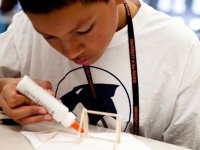Engaging Students in Math
Your content has been saved!
Go to My Saved Content.The last month has seen a plethora of discussions about the necessity for teaching math beyond what most jobs consider necessary. Much of it started from Andrew Hacker's now infamous article on whether math is necessary, to which a bunch of us replied with equal fervor (Dan Willingham's and Sherman Dorn's pieces are great rejoinders). What we all seem to agree on is that, indeed, the way we teach math matters. Lots. Having a positive environment for kids where they feel like they can actually do math without feeling like they're complete failures matters a lot.
Often, that starts with us as teachers.
Developing an environment where students can experiment and gain entry into the language of math starts with having a person who can facilitate what Stephen Krashen termed a low affective filter environment. While his study was applied to English Language Learners, his hypotheses should apply to all subject areas, math highest among them.
In my classroom, I have five principles for assuring that all students can enter into the math, and also for creating the conditions for math success.
1) Allow More Mistakes
I would suggest this to just about every teacher, but specifically math teachers, especially those of us who use the word "wrong" a lot. We should strike a balance between using direct instruction and exploration, leaning more on the exploration piece. Once we allow more mistakes, we let students into the process that our earliest mathematicians used in developing the axioms we believe today. Also, by admitting that we all make mistakes, it sends a clear signal to kids that they can be mathematicians, too. Surely, I'm not suggesting that we let the mistakes be. Yet, when I make a mistake on the board (intentionally or otherwise), I hope my students catch onto that, thus putting them in the position of expert. Speaking of which . . .
2) Support Their Struggle
At first, most of us get nervous when children struggle with mathematics, as if they need to get the math as soon as they receive the instruction. Even if it might look simple to us, the students may still be grappling with the skills, the concepts or both. That's OK. When students struggle with the material, they learn how to work problems out on their own as self-motivated workers. Of course, that also means the teacher needs to encourage them as often as possible to do so. If students think their efforts have no merit, then they often won't own it. In an environment where teachers support students' working through a problem, a teacher can tell when a student has quit. You have an option before you intervene . . .
3) Let the Kids Teach, Too
During the class period, I prefer the students speak more than I do. If I'm talking too much, that means I'm using too much of my speaking quota. In other words, they'll tune me out if I'm talking too much. Once I let the students speak (meaning, not just one student, but many), they take even more ownership of the math taught to them. This especially proves true during the class work time as well. Having them explain to each other (with the proper guidance) really empowers them to own the material and develop their own process for checking answers. Plus, I’m not exceeding my speaking quota. However . . .
4) Answer a Question with More Questions
If, in fact, a student asks us a question, we ought to validate their question by giving them another question. That way, we ensure that the onus for the "answer" falls on them. The type of questions we ask and the way we frame questions matters here, too. Questions that generate a "yes" or "no" answer simply won't do. Instead, we can leave them with a question that they can answer. I do emphasize the word "leave" because it's always good for you to walk away without explicitly telling them they were right. By the time you leave, they should already know this.
5) Personalize the Questions
Inserting children's names into the problems (appropriately) engages students in the material. As you start the problem, speaking about the student in the third person immediately gets him or her engaged, and gives the other students a window into the problem. Knowing the person in the problem (even if the situation itself is hypothetical) gives the entire class a sense of ownership and belonging within the math. Obviously, teachers should spread the wealth in naming people, because it may look like we're playing favorites or just focusing on the "struggling" children. All children need access to the math.
This advice obviously takes time and a teacher's willingness to fail. This also might push some of my colleagues out of a comfort zone. Yet we as teachers have to set a precedent for the success of lifelong learners, not just until a standardized test comes. One of the ways we set our students up for this type of success is by providing conditions for questioning, experimentation and ownership to happen. Those of us who only want to "skill and drill" students perpetuate attitudes that Hacker alluded to in his piece.
Math literacy matters. Let's do our part.
